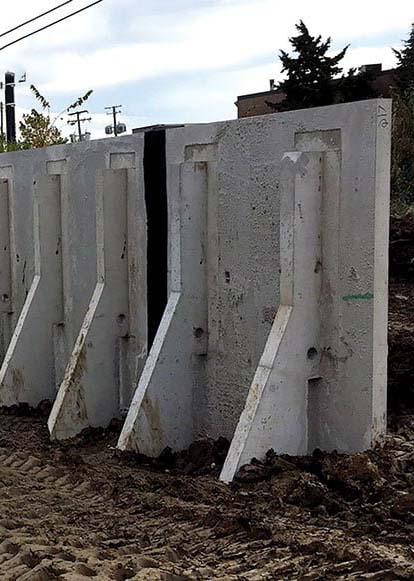Counterfort Walls
Request A Free Quote!
COUNTERFORT WALLS
Counterfort retaining walls are similar to cantilever walls except they have thin vertical concrete webs at regular intervals along the backside of the wall. These webs are known as counterforts.
The counterforts tie the slab and base together, and the purpose of them is to reduce the shear forces and bending moments imposed on the wall by the soil. A secondary effect is to increase the weight of the wall from the added concrete.
Can be precast or formed on site.
Counterfort retaining walls are more economical than cantilever walls for heights above 25 ft.
Similar to cantilever walls, counterfort walls require support along the backside of the wall. They use concrete webs, also known as counterforts, build at an angle to strengthen the stability of the wall. These webs are located at regular intervals along the length of the wall and reduce the natural pressures put on the wall from the soil while also increasing the weight of the wall. These are preferred over cantilever walls when the wall is taller than 25’.
The counterfort retaining wall is a retaining wall with counterforts attached to the inside face of the wall to resist further lateral thrust, and materials used for retaining walls are treated lumber, concrete block systems, stone, brick, and poured concrete.

The stem and the base and base slab are tied together by counterforts at suitable intervals in the counterfort retaining wall and the vertical stem. The hell slab acts as a continuous slab because of the provision of counterforts.
To counterforts, the stem and heel slabs are effectively fixed, so the stem bends horizontally between the counterforts due to lateral earth pressure. Thus, due to reducing the moment, the stem and the heel slab thickness are considerably reduced.
To reduce the shear forces and bending moments imposed on the wall by the soil, the counterforts tie the slab and base together. For height over about 6m, a counterfort retaining wall is economical and is adopted for larger heights.
These walls can be precast or formed on-site, and heights above 25 ft more economical than cantilever walls.
PARTS OF COUNTERFORT RETAINING WALL:
There are the following parts of the counterfort retaining wall as given below;
- Stem
- Toe Slab
- Heel Slab &
- Counterforts
DESIGN OF COUNTERFORTS:
From the stem, counterforts are subjected to outward reactions and produce tension along the outer sloping face of the counterforts. The counterforts are designed as a T-beam of varying depth due to the inner face supporting the stem is in compression, and at both ends, the primary steel provided along the sloping face shall be appropriately anchored.
There are the following advantages of these walls such as;
ADVANTAGES OF COUNTERFORT RETAINING WALL:
- These walls are more economical to tie the vertical wall with the heel slab by counterforts.
- To support vertical walls, this wall acts as a tension member.
- This wall reduces the bending moment and supports the hell slab.
- By weight of the earth and by self-weight, stability is maintained.
- From 6m to 8m, this wall height ranges.
- These walls are more widely used because it is hidden beneath the retained materials.
- For more efficient space in front of the wall, these walls have a clean and uncluttered face.
